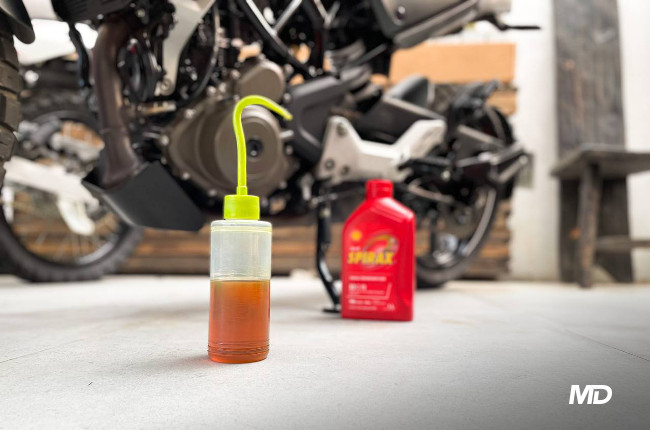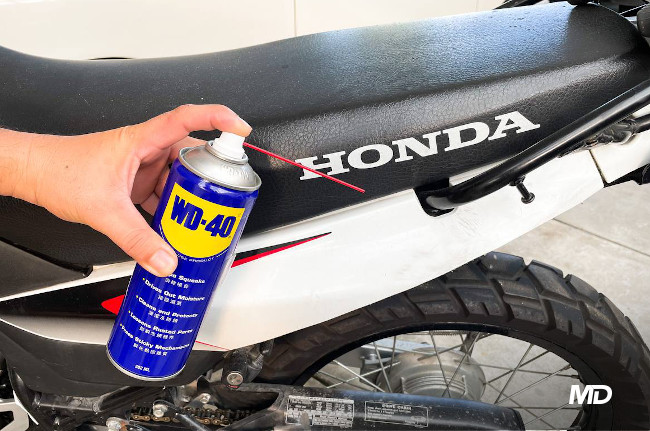5 motorcycle maintenance hacks for everyday DIY
Make your garage work easier with these DIY hacks.

If you’ve ever worked on your own motorcycle at home, you may find that certain inconveniences can really work against the rhythm of your work. Anything from having to clean up unnecessary oil spills, being frustrated with persistent stains, or simply having a hard time drying your motorcycle after a good wash. While it is frustrating to deal with a few of these inconveniences, finding a solution to our garbage problem can be quite the relief we all need. If you’re an avid DIYer looking for an easier time in the garage, a few of these maintenance hacks may very well be some of the solutions you’re looking for.
Chain lubrication

Finding the right lubricant for our motorcycle chains can be a tricky subject. Many owners will swear by expensive and branded lubricants for your chain, and on the flip side, other motorcyclists claim that cheap multipurpose oils will do the trick. Proper chain maintenance, however, can be done properly without skimping on cheap oils and without having to break the bank. Manual transmission fluid (MTF) or gear oil has been the go-to chain lubrication oil for many motorcyclists before mainstream and branded chain lubricants hit the market. A bottle of 90 weight gear oil will cost you a mere P300 or less and can last for about a year. When compared to mainstream and branded lubricants, gear oil protects and lubricates chains just as well—if not better, making it a great hack for those who maintain their own chains at home.
Trash bags

If you’ve ever attempted an oil change or coolant flush job at home, you might know the difficulty of having to find a suitable drain pan for the job and the pain of disposing of the old fluids and cleaning the pan afterward. Trash bags, however, make for a great way to dispose of old fluids. Simply get a small or medium-sized trash bag and wrap them over a small bucket or container. Your fluids can drain straight into the trash bag, which can then be tied shut for proper disposal later on at a proper disposal center. You won’t need to purchase additional drain pans, nor will you have to deal with cleaning engine oil out of a pan.
WD-40 deep clean

Acid rain and the variety of dust and dirt on the road can make for an unhealthy combination of contaminants for your motorcycle chassis and body panels. Some motorcyclists will know the pain of having to deal with pesky stains that won’t seem to scrub away no matter the strength of soap you use. If you’re cleaning your motorcycle and find a few stubborn stains that won’t ever seem to clean away with a normal wash, you might want to consider using a small amount of WD-40. Simply spray a small amount of the WD-40 lubricant on the dirty and lightly scrub away with a microfiber towel. If the stain does not go away, do not scrub harder—you might need a professional detailing job instead. But if the stain does go away, make sure to wash away the remaining WD-40 from your motorcycle with soap and water immediately as WD-40 can be harmful to your paint and plastics if left on for prolonged periods of time.
Homemade degreaser

If you don’t have WD-40 at home for stain removal and are looking for a cheap, homemade solution to clean heavy stains on your body panels, chassis, and engine, you might want to consider creating your own homemade degreaser. For this garage recipe, you will need 1 part baking soda, 4 parts of liquid soap, and 16 parts of white vinegar. Mix the solution together until fully blended and pour into a spray bottle for usage on your motorcycle components. Make sure to give the bottle a quick shake and spray on a healthy amount of your homemade degreaser on your motorcycle components. As with any degreaser, leave the solution to sit on the motorcycle for a few minutes before scrubbing off gently. Make sure to clean your solution from your motorcycle with soap and water afterward in order to protect your components.
Drying after washing

A motorcycle wash is never complete without a thorough drying job. Unlike cars however, drying a motorcycle with a towel is not as straightforward. While certain plastic components and body panels may be easy to wipe, having to dry off the chassis and engine area can be a bit tiresome and difficult given how tight the space can be. If you’re looking for a way to quickly dry off these areas, simply fire up your motorcycle’s engine and let the heat speed up the evaporation process. You can even take your motorcycle for a quick spin around the block to shake up the suspension components for faster drying. Just make sure that your motorcycle is squeaky clean when you end up drying your motorcycle this way as you will not want a mix of dirt and water to dry out and stain your bike through this process.
Related Articles
-
5 DIY maintenance jobs that can save you lots of money / Featured Article
Here are 5 do-it-yourself maintenance jobs that you can learn. Doing these maintenance items yourself not only help you learn more about your bike, but will help you save money in the proces...
-
5 things that could save your life during a motorcycle-related emergency / Featured Article
Find out how you can help prepare yourself for a variety of emergencies on the road.
-
These 3 signs tell you it's time for a new chain and sprocket / Featured Article
Never ignore these 3 warning signs that could mean that your bike needs a new chain and sprocket.
-
Follow these 3 tips to extend the service life of your motorbike’s battery / Featured Article
A motorcycle’s battery is considered as the heart of its electrical system, as such, taking good care of your battery can dramatically extend its lifespan.
-
Is your motorcycle out of warranty? Be sure to check these items ASAP / Featured Article
If your motorcycle is out of warranty, it’s now your duty to make sure you stay on top of its maintenance no matter what, or run the risk of facing a hefty repair bill.
Latest Features
-
Last-minute Christmas gift ideas for your rider friends and family / Featured Article
Struggling to think of gift ideas for your motorcyclist friends and family? Read on to get some inspiration this gift-giving season.
-
Ride a naked sportbike? Get these 5 upgrades first / Featured Article
Here’s a quick list of 5 upgrades to your naked sportbike to enhance your riding experience.
-
Motorcycle 101: The inner workings of a slipper clutch / Featured Article
Slipper clutches are awesome as they make for more forgiving downshifts and a lighter clutch lever. Let’s take a closer look at them and see how they work.








